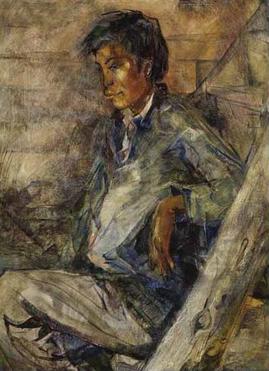Susan Ross (artist) facts for kids
Susan Andrina Ross (born June 3, 1915 – died January 5, 2006) was a talented Canadian artist. She was a painter, printmaker, and illustrator from Port Arthur, Ontario. Susan Ross is famous for her amazing portraits of Indigenous and Inuit people. She also painted beautiful landscapes of the Arctic. Her art is important because it shows a way of life that was changing quickly. In 2002, she received the Order of Canada, a high honor for her work in Visual Arts.
Contents
Discovering Art: Susan Ross's Early Life
Susan Ross was one of four daughters born to Colonel and Mrs. Harry Ruttan in Port Arthur, Ontario. She loved to draw from a very young age. Her mother encouraged her to take art lessons. Susan continued her art studies through high school, where she learned about anatomy.
A big influence in her early life was her uncle, Robert Flaherty. He was a filmmaker known for his movie Nanook of the North. Her uncle showed her what it was like to travel widely and live with the Inuit people. He also helped her attend the Ontario College of Art in Toronto in 1933. In 1938, Susan left art college before graduating to marry Jim Ross. He was a lawyer and later a judge in Port Arthur. They had four children together.
Creating Art: Susan Ross's Work
After getting married, Susan Ross moved back to Port Arthur. She started her family and kept working on her art. In the 1940s and 1950s, she painted around Lake Superior, Rossport, and Whitefish Lake. She worked hard to be seen as a serious artist. She signed her art "S.A. Ross" or "SARoss" because women artists were not always taken seriously back then.
Susan was very active in the Port Arthur Art Club. This club held art shows at the local library. At that time, there was no public art gallery in the town. From 1951 to 1952, Susan taught art at Hillcrest High School. She loved trying new art methods. She experimented with textures, like scraping paint or using tissue and glue. She also mixed layers of watercolor paint with printed etchings. Her work helped bring new, modern art styles to Canada. Even though she always painted real things, her art showed hints of cubism, a style that uses geometric shapes.
Painting People: First Nations and Inuit Portraits
Susan Ross continued to love painting portraits. She painted friends and children from her neighborhood. But she soon found new inspiration in Indigenous people. This happened after she met an Ojibwa woman named Emily. She also saw First Nations people harvesting wild rice at Whitefish Lake.
After the Second World War, Ross met Sheila Burnford. Sheila was the author of The Incredible Journey, a famous animal story that Walt Disney later made into a movie. Susan Ross and Sheila Burnford became good friends and traveled a lot together.
An artist named Norval Morrisseau invited Susan to paint in Gull Bay and Armstrong. He collected legends and songs there. Later, they traveled to Big Trout Lake and then to Sandy Lake. In Sandy Lake, Susan Ross met Carl Ray, another artist, and painted his portrait. She painted many other people there too. Susan and Norval remained friends for many years. A sketch by Morrisseau called "Susan" shows their friendship. It is now kept at the National Gallery of Canada.
Traveling North: Capturing Arctic Life
Susan Ross returned to Big Trout Lake several times between 1963 and 1975. She also went back to Sandy Lake from 1965 to 1967. Then she visited Little Grand Rapids in Manitoba from 1967 to 1970.
After that, Susan looked even farther north for her art. She traveled with Sheila Burnford to Pond Inlet, Baffin Island, in 1970–71. She also visited Coppermine, NWT, many times between 1972 and 1983. Other trips included Hollman Island, NWT, Cape Dorset, Baffin Island, Pangnirtung, Baffin Island, Rae-Edzo, NWT, and Kasechewan, Ontario. On these trips, Susan made many new friends.
Traveling in the North was not always easy. Susan faced many challenges in the harsh Arctic lands. For example, once, she was returning to Cape Dorset from a small island with a group. The motor on their boat stopped working. They drifted for four hours! They tried to use a sail, but it didn't help. Finally, they fired gunshots to get help from a nearby village. Luckily, they were towed to safety.
Etchings and Documenting Change
In 1967, Susan Ross took a workshop on etching with Jo Manning. In 1969, she bought her own printing press. She then started making high-quality etchings. She used the many sketches she made during her travels. This helped her create more detailed and structured images in her studio.
Susan Ross was in the "right place at the right time" during a big period of change in Canadian history. She was able to capture and document how many northern communities were changing quickly. Her art shows the "human toll" of these changes in the faces of people and in the details of their daily lives.
Susan Ross also illustrated several books. She drew pictures for Sheila Burnford's books "Without Reserve" and "One Woman's Arctic," which tell about their travels. She also illustrated Penny Petrone's "Fairy Tales of Isabella Valancy Crawford" and Jocelyn Square's "SHA-KO-KA." Her artwork was also featured on the covers of the Canadian magazine "The Beaver."
Susan Ross was important in helping other artists. She helped set up the first art shows for both Carl Ray and Daphne Odjig. She was a "mentor," meaning she guided and encouraged many artists. She also helped them financially.
Images for kids





